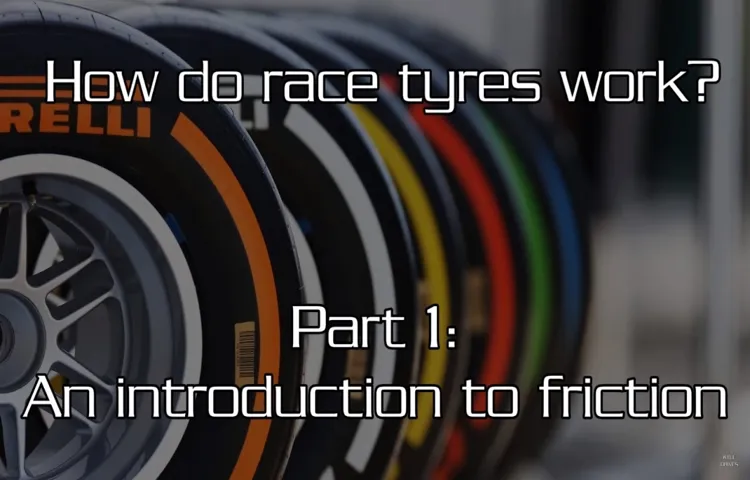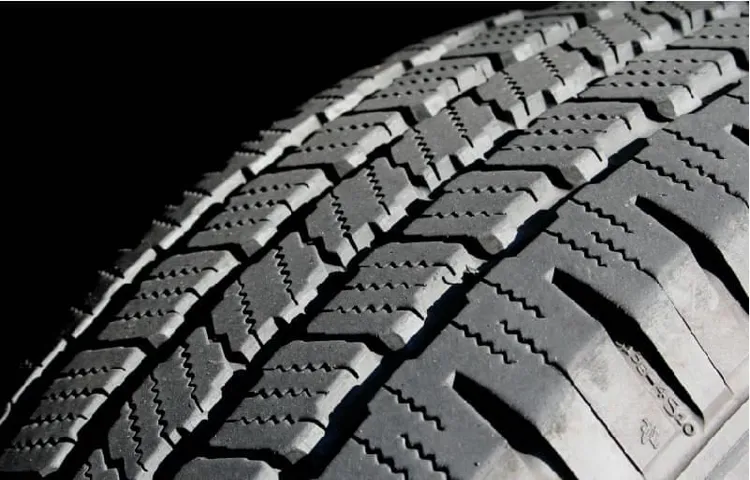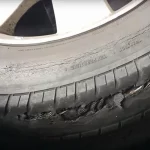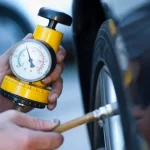Tires are an essential component for vehicles as they ensure safety and comfort. While most people focus on the aesthetics of their tires, the treads play a significant role in how the tire performs on different road surfaces. Tire treads are a science that involves the design, construction, and testing of the tread pattern.
The tread design can affect a tire’s performance in various ways, from fuel efficiency to grip on wet surfaces. In this blog post, we will delve into the science of tire treads to understand how they work and the different types available. So, let’s dive in!
Table of Contents
What are Tire Treads?
Tire treads are the patterned grooves on the surface of the tire that come in contact with the road. Treads work to increase or decrease friction, which is vital when it comes to ensuring stability and safety while driving. Treads vary in depth, width, and pattern, depending on the type of tire and its intended use.
Generally, the deeper and wider the treads are, the better the traction a tire can provide. This is because the channels between the treads channel away water and prevent hydroplaning. In addition, the jagged edges and sipes in the treads help to grip the road, providing traction on both wet and dry roads.
However, when the treads are worn down, the surface of the tire becomes smoother and friction decreases, which can increase the risk of losing control on the road. Regularly checking tire pressure and maintaining proper tread depth is essential for maximizing the lifespan of tires and ensuring safe driving conditions.
Function of Tire Treads
Tire treads are the grooves on the surface of a tire that allow it to grip the road and provide traction. These grooves serve a vital function in ensuring safety while driving, especially during wet or icy conditions. The deeper the treads, the better the tire will perform in adverse weather conditions.
The treads are designed to channel water away from the tire, preventing hydroplaning and ensuring that the tire maintains contact with the road surface. This is important because hydroplaning can cause loss of control and lead to accidents. Additionally, the treads also provide better traction on rough or uneven surfaces, such as gravel or dirt roads.
The design and depth of the treads can vary depending on the type of tire and its intended use. For example, off-road tires have deeper treads to provide better grip on uneven terrain. Proper maintenance of tire treads, including regular rotation and replacement, is essential to ensure safe driving and prolong tire life.

How Tire Treads Affect Friction
Many people may not realize the importance of tire treads and how they affect friction. Treads are the patterned lines on the surface of a tire that come into contact with the road. They work to increase or decrease friction based on their design.
Treads are particularly important in wet or slippery conditions. When water or other slippery substances come between the tire and the road, the treads help to channel the substances away from the tire, allowing it to maintain contact with the road surface. This prevents hydroplaning and ensures safe driving.
Tire treads can also affect handling and stability. Different tread patterns are designed for different driving conditions and tire types. Smaller, more tightly packed treads are better for snowy conditions, while wider, deeper treads are more suitable for off-road terrains.
Overall, tire treads play a crucial role in vehicle safety and performance, and should not be overlooked when choosing or maintaining tires.
Tread Depth and Wet Weather
Tread depth is an essential aspect to consider when it comes to wet weather driving. As the depth of the tire tread decreases, the capability to evacuate water decreases too. Consequently, when driving in wet conditions, tires with a decreased tread depth become more difficult to handle as they have less grip on the road.
This leads to an increased risk of hydroplaning, a situation in which the vehicle’s tires lose traction with the ground and glide over the surface of the water. If you’re an avid driver who frequently commutes in wet weather, it’s essential to check your tire tread depth frequently to guarantee your safety and those of your passengers. As a rule of thumb, if the depth of your tire treads goes below 2/32 of an inch, it’s time to consider getting new tires.
Always ensure that your car is equipped with tires that are appropriate for the type of weather conditions you’ll encounter, as it can mean the difference between a safe and risky experience.
Tire Treads and Cornering
When it comes to driving, we all know that the condition of our tires plays a crucial role in keeping us safe. However, it’s not just about the tire pressure, but also the tire treads that determines how much friction the tire can generate. The deeper the tire treads, the better the tire can grip the road, especially in wet or slick conditions.
This is especially important when it comes to cornering. A tire with shallow treads may have a harder time gripping the road during a turn, leading to a higher risk of losing control and skidding. On the other hand, a tire with deeper treads can maintain better contact with the road during cornering and provide more stability, allowing for safer maneuvering.
In short, tire treads can make a big difference in how well a car handles, especially in hazardous conditions. So, never overlook the importance of checking your tires regularly and replacing them when needed to ensure a safe and smooth driving experience.
Tire Treads and Braking
Tire treads play a crucial role in how our vehicles behave on the roads, especially when it comes to braking. The design and condition of the treads can greatly affect the amount of traction and friction between the tires and the road surface. The deeper the grooves of the treads, the better they can grip the surface and disperse water or debris, giving us more control over our vehicles.
On the other hand, worn out or bald tires with shallow treads can be dangerous as they can easily lose traction, particularly on wet or slippery roads. It’s crucial to regularly check your tires and replace them if the treads have gone past their limits. Investing in good quality tires with proper tread patterns can not only enhance your braking performance but also improve your overall driving experience.
Factors That Affect Tire Tread Wear
Tire treads play a critical role in determining how well your vehicle can grip the road surface and maintain stability while driving. Tire treads work by creating friction between the tire and the road, which allows the vehicle to accelerate, corner, and brake safely. However, there are several factors that can affect tire tread wear and ultimately decrease the ability of the tire to maintain grip.
One of the most significant factors affecting tire tread wear is road surface conditions, such as harsh weather conditions or an uneven road. Another factor is the driving style of the person behind the wheel. Aggressive driving behaviors can cause excessive wear and tear on the tire and reduce the lifespan of the tread significantly.
In addition to these factors, periodic tire maintenance such as balancing and alignment can also impact how well the tire treads are functioning. Proper tire inflation also affects the wear of the tread. Overall, understanding how tire treads work and taking proper care of your tires is crucial to ensure that your vehicle can maintain traction, stability, and safety on the road.
Road Conditions
When it comes to maintaining the lifespan of your tires, there are several factors to consider, one of which is road conditions. Poor road conditions can cause significant wear and tear on your tires, leading to a shorter lifespan and costly replacements. Some of the main factors that can affect tire tread wear include the type of road surface, the frequency of driving on the road, and the weather conditions.
Rough, uneven road surfaces like gravel or unpaved roads can cause accelerated wear on your tires, whereas smooth, well-maintained surfaces like highways or city streets are less damaging. Additionally, frequent driving on the same road can cause tire wear in specific areas, leading to uneven tread wear. Finally, harsh weather conditions like extreme heat or cold, heavy rain, or snow and ice can all cause significant wear on your tires.
To extend the life of your tires, be sure to drive cautiously and avoid roads that are in poor condition whenever possible. Additionally, regular tire maintenance, including balancing and rotating your tires, can help ensure even wear and a longer lifespan for your tires.
Driving Habits
When it comes to the lifespan of your tires, your driving habits play a significant role. There are several factors that can affect the tread wear of your tires, including how you drive, the type of road conditions you encounter, and the weather. If you frequently accelerate and brake hard, your tires will wear out much faster than if you take it easy on the gas and brakes.
Similarly, if you tend to drive on rough or uneven roads, your tires will wear down more quickly than if you stick to smooth pavement. And of course, if you regularly drive in wet or icy conditions, your tires will experience more wear and tear than if you only drive in dry conditions. All of these factors can have a big impact on the lifespan of your tires, so it’s important to be mindful of your driving habits if you want to get the most out of your tires.
By driving sensibly and avoiding harsh conditions whenever possible, you can help ensure that your tires last as long as possible, saving you money and hassle in the long run.
Maintaining Proper Tire Tread Depth
Tire treads are designed to increase friction and provide better grip on the road. Maintaining proper tire tread depth is critical for safe driving and optimal performance. As tires wear, their treads become shallower, reducing their ability to channel water, ice, and snow away from the surface of the tire.
This can lead to hydroplaning, reduced traction, longer stopping distances, and a higher risk of accidents. On the other hand, new tires with deeper treads have better grip and can perform well in a wide range of weather and road conditions. Proper tire maintenance, including regular inspections and rotations, can help extend the life of your tires and ensure that they provide the optimal level of performance and safety.
So, if you want to stay safe on the road and get the most out of your tires, make sure to keep an eye on your tread depth and replace your tires as needed.
Conclusion
In conclusion, tire treads are like tiny superheroes fighting against the forces of friction. They work to increase or decrease friction depending on the driving conditions, keeping our vehicles and ourselves safe on the road. So, next time you see a tire, give a little nod of gratitude to those trusty treads, keeping us grounded and on the move.
“
FAQs
What is tire tread and how does it affect friction?
Tire tread refers to the pattern of grooves and ridges on a tire’s surface. Depending on the design and depth of the tread, it can increase or decrease friction between the tire and the road.
Can tire tread help prevent hydroplaning?
Yes, tire tread is specifically designed to channel water away from the tire’s contact patch with the road. This reduces the risk of hydroplaning, which occurs when a layer of water builds up between the tire and the road, leading to loss of traction.
How does tire wear affect friction?
As a tire tread wears down over time, it becomes shallower and less effective at maintaining friction with the road. This can lead to reduced grip and poorer handling, especially in wet or slippery conditions.
What is the difference between all-season and winter tires in terms of friction?
Winter tires typically have deeper and more aggressive tread patterns than all-season tires, which enhances their ability to grip snow and ice. However, this also means that they may have decreased dry-road traction, making them less suitable for year-round use.
How do different tire materials affect friction?
The composition of a tire’s rubber can affect its grip on the road. Softer rubber compounds tend to offer better traction, but they also wear out more quickly. Harder compounds can last longer but may sacrifice some grip.
How can tire pressure affect friction?
Tire pressure can affect the size and shape of a tire’s contact patch with the road, which in turn affects friction. Underinflated tires can lead to increased rolling resistance and decreased grip, while overinflated tires can reduce the size of the contact patch and lead to uneven wear.
Can tire tread patterns affect noise levels?
Yes, some tire tread patterns are designed to minimize road noise and provide a quieter ride. However, this can come at the expense of some grip and handling performance.



